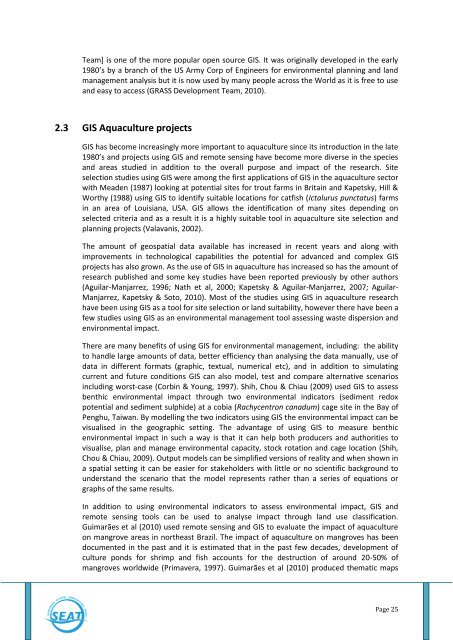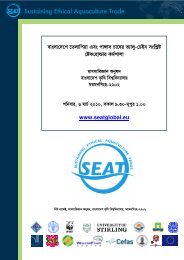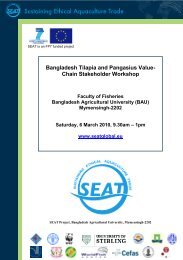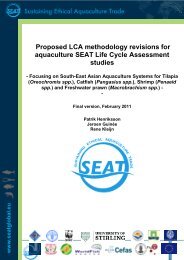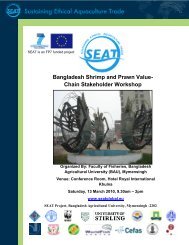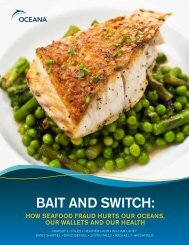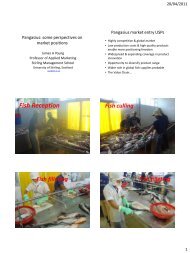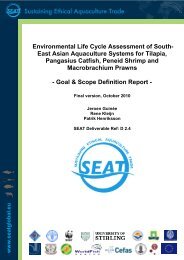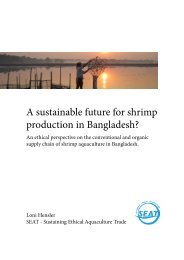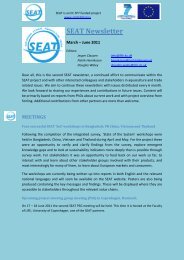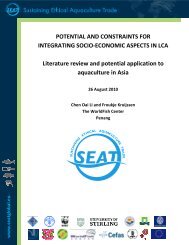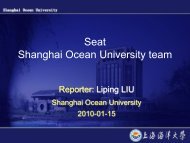D4.1 Review of Environmental Models - SEAT Global
D4.1 Review of Environmental Models - SEAT Global
D4.1 Review of Environmental Models - SEAT Global
You also want an ePaper? Increase the reach of your titles
YUMPU automatically turns print PDFs into web optimized ePapers that Google loves.
Team] is one <strong>of</strong> the more popular open source GIS. It was originally developed in the early<br />
1980’s by a branch <strong>of</strong> the US Army Corp <strong>of</strong> Engineers for environmental planning and land<br />
management analysis but it is now used by many people across the World as it is free to use<br />
and easy to access (GRASS Development Team, 2010).<br />
2.3 GIS Aquaculture projects<br />
GIS has become increasingly more important to aquaculture since its introduction in the late<br />
1980’s and projects using GIS and remote sensing have become more diverse in the species<br />
and areas studied in addition to the overall purpose and impact <strong>of</strong> the research. Site<br />
selection studies using GIS were among the first applications <strong>of</strong> GIS in the aquaculture sector<br />
with Meaden (1987) looking at potential sites for trout farms in Britain and Kapetsky, Hill &<br />
Worthy (1988) using GIS to identify suitable locations for catfish (Ictalurus punctatus) farms<br />
in an area <strong>of</strong> Louisiana, USA. GIS allows the identification <strong>of</strong> many sites depending on<br />
selected criteria and as a result it is a highly suitable tool in aquaculture site selection and<br />
planning projects (Valavanis, 2002).<br />
The amount <strong>of</strong> geospatial data available has increased in recent years and along with<br />
improvements in technological capabilities the potential for advanced and complex GIS<br />
projects has also grown. As the use <strong>of</strong> GIS in aquaculture has increased so has the amount <strong>of</strong><br />
research published and some key studies have been reported previously by other authors<br />
(Aguilar-Manjarrez, 1996; Nath et al, 2000; Kapetsky & Aguilar-Manjarrez, 2007; Aguilar-<br />
Manjarrez, Kapetsky & Soto, 2010). Most <strong>of</strong> the studies using GIS in aquaculture research<br />
have been using GIS as a tool for site selection or land suitability, however there have been a<br />
few studies using GIS as an environmental management tool assessing waste dispersion and<br />
environmental impact.<br />
There are many benefits <strong>of</strong> using GIS for environmental management, including: the ability<br />
to handle large amounts <strong>of</strong> data, better efficiency than analysing the data manually, use <strong>of</strong><br />
data in different formats (graphic, textual, numerical etc), and in addition to simulating<br />
current and future conditions GIS can also model, test and compare alternative scenarios<br />
including worst-case (Corbin & Young, 1997). Shih, Chou & Chiau (2009) used GIS to assess<br />
benthic environmental impact through two environmental indicators (sediment redox<br />
potential and sediment sulphide) at a cobia (Rachycentron canadum) cage site in the Bay <strong>of</strong><br />
Penghu, Taiwan. By modelling the two indicators using GIS the environmental impact can be<br />
visualised in the geographic setting. The advantage <strong>of</strong> using GIS to measure benthic<br />
environmental impact in such a way is that it can help both producers and authorities to<br />
visualise, plan and manage environmental capacity, stock rotation and cage location (Shih,<br />
Chou & Chiau, 2009). Output models can be simplified versions <strong>of</strong> reality and when shown in<br />
a spatial setting it can be easier for stakeholders with little or no scientific background to<br />
understand the scenario that the model represents rather than a series <strong>of</strong> equations or<br />
graphs <strong>of</strong> the same results.<br />
In addition to using environmental indicators to assess environmental impact, GIS and<br />
remote sensing tools can be used to analyse impact through land use classification.<br />
Guimarães et al (2010) used remote sensing and GIS to evaluate the impact <strong>of</strong> aquaculture<br />
on mangrove areas in northeast Brazil. The impact <strong>of</strong> aquaculture on mangroves has been<br />
documented in the past and it is estimated that in the past few decades, development <strong>of</strong><br />
culture ponds for shrimp and fish accounts for the destruction <strong>of</strong> around 20-50% <strong>of</strong><br />
mangroves worldwide (Primavera, 1997). Guimarães et al (2010) produced thematic maps<br />
Page 25


